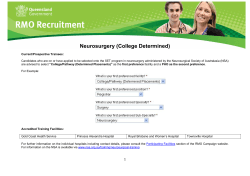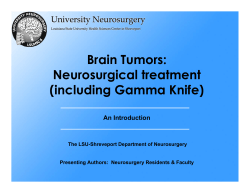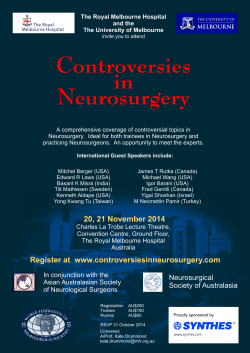
book here
Brain Tumors in Children Introduction Last year, 60 children were newly diagnosed and treated for brain tumors at Cincinnati Children’s. Growth in the Greater Cincinnati population and changes in referral patterns may account for this increased number. While brain tumors in children are quite rare, a primary care provider still may have a child present with symptoms of a brain tumor. The signs and symptoms can be highly variable according to age and location. This publication will attempt to review the common presentations for children with brain tumors and recommendations for care. accelerated head growth, a bulging anterior fontanelle, splayed cranial sutures, developmental delay, loss of developmental milestones, lethargy and vomiting, and failure to thrive may prompt imaging studies to exclude intracranial pathology. Common signs and symptoms in children with brain tumors, by age: Statistics In children less than 15 years of age, brain tumors constitute the most common solid tumor in children. Brain tumors also comprise 20 percent of all childhood cancers. In the United States, approximately 1,700 new cases are diagnosed each year, or about 25-30 new brain tumors per million child population. Each year approximately 60 children diagnosed with new brain tumors are evaluated and treated at Cincinnati Children’s Hospital Medical Center. Children, now with fused but still growing skulls, typically are verbal and more communicative than infants. They are more likely to complain of headache, blurred vision, nausea and vomiting, or difficulties in the routine use of their arms or legs, including poor balance or coordination. Having started school, they may exhibit declining school performance as well. Presentation by Age Infants, school-aged children and adolescents may present with differing signs and symptoms due to both the types of tumors seen in these different age groups and to the accommodating skull size of the infant. In infants and toddlers who have an open anterior fontanelles and unfused sutures, symptoms may be more generalized and less focal than in the older child. As with the child in whom hydrocephalus is a concern, The adolescent child, nearing adulthood, can articulate subtle symptoms caused by a brain tumor, such as sensory changes, diplopia or progressive headache. Generally speaking, isolated or chronic headaches typically do not indicate the presence of a space-occupying lesion. A new onset seizure in an older adolescent would be less common than those commonly seen in younger children, and as in adults, may be the presenting symptom of a brain tumor. A New Outpatient Location in West Chester! We recently opened a pediatric neurosurgery clinic at the new Cincinnati Children’s Outpatient West Chester, located off I-75 in the University Pointe medical facility. For more information, call the Department of Pediatric Neurosurgery at 513-636-4726 or 1-800-344-2462, ext. 4726. Outpatient West Chester Our staff holds weekly outpatient clinics at this location. The office is very convenient, just minutes from the I-75/Tylersville Road interchange, and is centrally located between Dayton and Cincinnati. 7700 University Court, West Chester, OH 45069 For more information about Pediatric Neurosurgery visit www.cincinnatichildrens.org/neurosurgery. Radiology Imaging should be considered when there is new or progressive neurologic deficit or worsening headache. This would include the very suspicious morning headache that may or may not be accompanied by vomiting. CT and MR are the most frequent studies by which brain tumors are imaged. CT demonstrates bony anatomy and calcified lesions most adequately, while MR is superior for soft tissues. A CT of the brain generally is adequate as a screening tool in a child with no specific findings and a low index of suspicion of harboring a tumor. With the quality of CT scanning, the majority of tumors of the brain are revealed. age tend to be very aggressive and malignant. Conversely, the older the child, the more likely the diagnosis will favor a less malignant tumor. Supratentorial tumors include various grades of gliomas, such as gangliogliomas and oligodendrogliomas, as well as intraventricular tumors, such as choroid plexus papillomas. Suprasellar tumors are largely craniopharyngiomas or optic pathway gliomas, and the pineal region tends to harbor germinomas and non-germinomatous germ cell tumors. Typical tumors in the posterior fossa include the more benign juvenile pilocytic astrocytomas, the more malignant medulloblastoma and ependymomas, and the devastating diffuse pontine glioma. Treatment Figure 1: MR of the brain with contrast enhancement revealing a large left temporal lobe oligodendroglioma in a 3-year-old child presenting with a bulge over the left ear. MR imaging is much more sensitive and specific for defining tumors of the brain. MR should be reserved for children with suspicious CT scans, or children with very focal signs and symptoms indicating a high probability of intracranial pathology. Both CT and MR angiography can be used to evaluate the involvement of major arteries and dural venous sinuses. Formal angiography is not commonly utilized in the treatment of brain tumors except in the preoperative evaluation and possible endovascular occlusion of significant feeding vessels that would decrease the risk and enhance the result of surgery. Not only has imaging aided in early detection, but also in tumor staging. If an MR has been ordered, and there is concern about the malignant behavior of a brain tumor, concomitant spine imaging may prove helpful in ruling out metastases. In the case of both benign and malignant tumors, pre and postoperative imaging aids in monitoring the results of surgery, as well as the therapeutic results of adjuvant therapies. In addition, postoperative complications, which may not be clinically evident, may be detected and addressed prior to the development of subsequent problems. Histopathology Many different types of brain tumors may occur in children. Although younger children are more likely to harbor posterior fossa tumors located in the cerebellum or brainstem, half of all childhood tumors are in the posterior fossa and half are supratentorial affecting the cerebrum. In general, tumors found in children less than 2 years of Current Concepts in Pediatric Neurosurgery The hydrocephalus associated with brain tumors typically is obstructive in nature. Successful reduction or removal of the tumor oftentimes allows for the establishment of normal CSF flow dynamics and subsequent resolution of the hydrocephalus. If hydrocephalus persists, despite definitive tumor surgery, a CSF diversionary shunt may be placed, or an endoscopic third ventriculostomy (ETV) may be performed. For suspected obstructive hydrocephalus, and in the absence of previous radiation therapy, an ETV may allow for restoration of CSF flow without the need for a shunt. Brain tumors that are small, are located in eloquent cortex or deep structures, are felt to be slow growing, and have no mass effect may be followed conservatively, with periodic sequential radiographic imaging without surgical intervention. Many of these lesions are found incidentally, such as when imaging for mild head injury. Small benign lesions may be identified following new onset seizures. Treatment with medical management of the seizures and serial imaging to follow the tumor would be advised. Subsequently, intractable epilepsy, tumor progression or parental/surgeon consensus may lead to surgery. Figure 2: Sagittal MR of the brain revealing a large cystic posterior fossa tumor with an acquired Chiari malformation, severe brainstem compression, syringomyelia and hydrocephalus in a 5-year-old child presenting with ataxia and hand tremor. Because benign tumors have been known to change histologic characteristics and undergo malignant transformation into more aggressive tumors, they may become more invasive and more difficult to treat. Therefore children with surgically accessible tumors in non-eloquent areas of the brain should strongly be considered as surgical candidates. Surgery The goals of surgical intervention for children with brain tumors are establishing a tissue diagnosis; relieving increased intracranial pressure; and depending on the histology, behavior, location and size of the lesion, achieving complete resection. Surgical success also is based on the functional and neurologic outcome of the child. As such, every attempt is made to avoid neurologic injury. Surgical skill, experience and judgment all contribute to a desired outcome. Intra-operative decisions based on surgical findings, as well as preliminary histologic diagnosis, are paramount in achieving the best functional and surgical results. Benign tumors such as low grade gliomas often are treated by surgery alone. Optic tract gliomas and brain stem gliomas may be treated without surgery due to a low probability of cure and a high risk of severe permanent neurologic deficits. However, in many instances surgery may be followed by chemotherapy and/or radiation therapy as focused adjuvant therapy. marrow, may bring hope to children with malignant tumors that are resistant to conventional treatment or suffer tumor recurrence. Risks of chemotherapy involve the sequelae of bone marrow suppression and a compromised immune system. The side effects and potential complications from brain tumor treatments are as varied as the functions the brain controls. Therefore the treatment of children with brain tumors becomes a multidisciplinary effort. Frequently children have visual disturbances for which ophthalmology is consulted, growth alteration for which endocrinology is involved, fine and gross motor impairment, or cognitive impairment, which affects learning and behavior. Cincinnati Children’s has the appropriate resources, which are monitored through the oncology department, to meet these needs. The primary care provider, however, still is the pivotal patient advocate to ensure these children receive all the services that they need. The Division of Pediatric Neurosurgery Radiation Therapy The advent of radiation therapy has enhanced the treatment of both malignant and benign brain tumors. Administered in various dosing schemes, including focused stereotactic radiosurgery, radiation therapy now can be targeted to small lesions in sensitive or inoperable areas of the brain, such as the optic apparatus or the brainstem, with little damage to surrounding normal structures. Figure 3: CT scan of the head revealing a calcified craniopharyngioma and hydrocephalus in a 6-year-old child with short stature, visual field deficit and esotropia. In general, whole brain radiation is reserved for children older than 3 years of age because of the significant functional deficits that may result. These include perceptual-motor incoordination, maladaptive behavior and diminished intellectual capacity. Localized radiation at ages 7 and above, however, is associated with few late effects. Chemotherapy As with radiation therapy, chemotherapy may be used as primary therapy after biopsy, or as adjuvant therapy after partial or complete resection, depending on tumor pathology. These agents are aimed at killing cells that are dividing. They may be administered intravenously, as well as intrathecally, into the CSF pathways. Autologous stem cell rescue, aimed at introducing a new, tumor free bone About Our Staff, Services and Programs Cincinnati Children’s Hospital Medical Center has the largest and most comprehensive pediatric neurosurgical program in the region. Thorough evaluation and surgical care are available for all phases of neurological disease. Our entire team has a commitment to providing family-centered and prompt care to all our patients and their families. We work with our referring physicians – our partners in coordinated care – by providing state-of-the-art technological care, fullservice capabilities and specialized programs. Specialties include functional neurosurgery, cranial malformation and neuro-oncology. And all of our surgeons have received pediatric neurosurgery training in approved fellowship programs. Referrals, Appointments and Locations Surgical intervention and inpatient and outpatient neurosurgical consultations are available on a 24-hour basis. Appointments are available at our main campus near the University of Cincinnati and at Outpatient West Chester. For a referral or an appointment, call 513-636-4726 or 1-800-344-2462, ext. 4726. Meet Our Surgeons Kerry R. Crone, MD Stuart S. Kaplan, MD John S. Myseros, MD Division Director Kerry Crone, MD, has an international reputation as a leader in the field. He is one of the few neurosurgeons in the world considered an expert in endoscopic neurosurgery and is recognized as an "Outstanding Physician in America." Other special interests include skull base surgery, craniosynostosis, hydrocephalus and brain tumors. Dr. Kaplan’s specialties include general and functional neurosurgery, with subspecialization in medically refractory epilepsy, spasticity and brachial plexus surgery. Dr. Kaplan has experience and interest in neuroscience research and will assist in developing pediatric neurosurgery’s participation in the medical center’s mission to create and use knowledge to improve the lives of children. Dr. Myseros’ specialties include the treatment of brain tumors, neuro-oncology, radiosurgery, craniosynostosis, vascular malformation, hydrocephalus, spina bifida and neuro-trauma Dr. Crone has been at Cincinnati Children’s for more than 15 years. During that time he has performed more than 4,000 neurosurgical procedures on children and has built a reputation as a leader in pediatric neurosurgery. A graduate of the University of Cincinnati College of Medicine, Dr. Crone completed his internship in general surgery and his residency in neurosurgery at the North Carolina Baptist Hospital, Bowman-Gray School of Medicine in Winton-Salem. Dr. Crone also was a clinical fellow in pediatric neurosurgery at The Hospital for Sick Children in Toronto, and a clinical scholar in neurosurgery at Cincinnati Children’s. He is certified by the American Board of Neurological Surgery and the American Board of Pediatric Neurological Surgery. Current Concepts in Pediatric Neurosurgery offers medical education and the latest advances in pediatric neurosurgery. It is written and published by the staff of the Division of Pediatric Neurosurgery at Cincinnati Children’s. If you have comments or questions, please contact us at 513-636-4726 or 1-800-344-2462, ext. 4726 or send an email to mimi.miller@cchmc.org. Dr. Kaplan completed his neurosurgery residency and pediatric neurosurgery fellowship at Washington University Medical Center in St. Louis. He was awarded his undergraduate degree with honors from Dartmouth College and his medical degree from Harvard Medical School. Dr. Kaplan has achieved several honors through his research, including the National Institutes of Health National Research Service Award and The Southern Neurosurgical Society Basic Science Resident Award. Cincinnati Children’s Hospital Medical Center MLC 2016 3333 Burnet Avenue Cincinnati, OH 45229-3039 www.cincinnatichildrens.org Prior to coming to Cincinnati Children’s, Dr. Myseros was in private practice at the Inova Fairfax Hospital for Children. He also worked as a staff pediatric neurosurgeon and assistant professor of neurosurgery at the Allegheny University Hospital in Pittsburgh. Dr. Myseros received his doctor of medicine degree from Johns Hopkins University and completed his neurosurgery residency at the Medical College of Virginia in Richmond. He completed his pediatric neurosurgical fellowship at The Hospital for Sick Children in Toronto and is certified by the American Board of Neurological Surgery and the American Board of Pediatric Neurological Surgery.
© Copyright 2025










